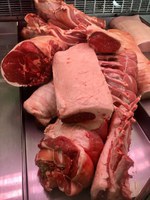Purchasing Meat Directly From Producers an Option
(Click the image below to view a high-resolution image that can be downloaded)
The COVID-19 pandemic is forcing large regional meat processing plants to close, which could result in meat shortages at some grocery stores.
“Livestock producers may not have a sustainable place to sell their animals this summer without evaluating alternative options,” says Travis Hoffman, North Dakota State University and University of Minnesota Extension sheep specialist.
“One option is for consumers to buy meat or an animal directly from the producer,” says Angie Johnson, NDSU Extension’s agriculture and natural resources agent in Steele County. “This is an alternative to consider in connecting producers and consumers to provide meat in today’s current situation.”
Livestock producers can send an animal to a local processing facility that is U.S. Department of Agriculture or state inspected and have animals slaughtered under inspection.
According to North Dakota inspection regulations, state-inspected establishments slaughter livestock and may process meat products under regulated inspection. These products contain the state mark of inspection and are eligible to be wholesaled within North Dakota, while meat harvested under USDA inspection may be sold across state lines.
“A producer can obtain a local or regional Department of Health license and a tax identification number to sell the meat products out of a producer’s home or business,” says Rob Maddock, an associate professor in NDSU’s Department of Animal Sciences.
Additionally, a processing facility may have a custom-exempt status. Custom-exempt facilities allow individuals to provide their own animal for slaughtering and processing. However, the owner of the animal is the sole owner of the meat that was produced from the animal.
If a neighbor, friend or a buyer wishes to receive meat from the animal, the individual must purchase the animal prior to harvest.
Custom-exempt slaughter facilities are not required to have each individual animal that enters the facility inspected through the slaughtering and processing steps, unlike state and federally inspected facilities. Custom-exempt facilities slaughter and process animals under minimized inspection. The producer can deliver an animal to a processor and then sell the “animal.”
“An individual, or up to eight people in North Dakota, can buy the live animal prior to harvest,” Hoffman says. “For example, consumers can purchase a quarter of beef, half a hog or half of a lamb and split the purchase and processing costs.”
In this case, only the family who bought the animal and nonpaying guests can use the meat. The main restriction is the buyer must pay the livestock producer for the animal or portion of the animal, so technically, the producer is not selling the meat. The buyer then typically pays the processor for the slaughter, processing and packaging.
“The meat cannot be resold or donated to a food bank or other similar entity if it was not slaughtered under inspection,” Maddock says.
“Our livestock producers can evaluate their marketing options and work to get on the schedule of slaughter for local harvest facilities and merchandise their livestock as meat for consumers,” Johnson says.
These restrictions do not apply to poultry. A producer can slaughter up to 20,000 chickens and a large number of other poultry such as turkeys, ducks or geese and sell the carcasses/meat without any inspection required.
Many resources are available to help producers and consumers during the COVID-19 pandemic.
“In addition to research-based information about animal science, NDSU Extension has a variety of resources for consumers related to preparing and preserving meat for safety and quality,” says Julie Garden-Robinson, NDSU Extension food and nutrition specialist. “See https://www.ag.ndsu.edu/food, which also includes information about food entrepreneurship as people explore new ways to market their agricultural products.”
The North Dakota Department of Agriculture has revised an interactive map to help consumers more easily find local foods, including beef, pork and poultry, in North Dakota. The map is available at https://www.nd.gov/ndda/NDLFMAP.
Also, a list of North Dakota meat processors can be accessed at https://tinyurl.com/MeatProcessors-ND.
NDSU Agriculture Communication - May 1, 2020
| Source: | Travis Hoffman, 701-231-2222, travis.w.hoffman@ndsu.edu |
|---|---|
| Source: | Rob Maddock, 701-231-8975, robert.maddock@ndsu.edu |
| Source: | Angie Johnson, 701-524-2253, angela.b.johnson@ndsu.edu |
| Source: | Julie Garden-Robinson, 701-231-7187, julie.garden-robinson@ndsu.edu |
| Editor: | Ellen Crawford, 701-231-5391, ellen.crawford@nsdu.edu |


